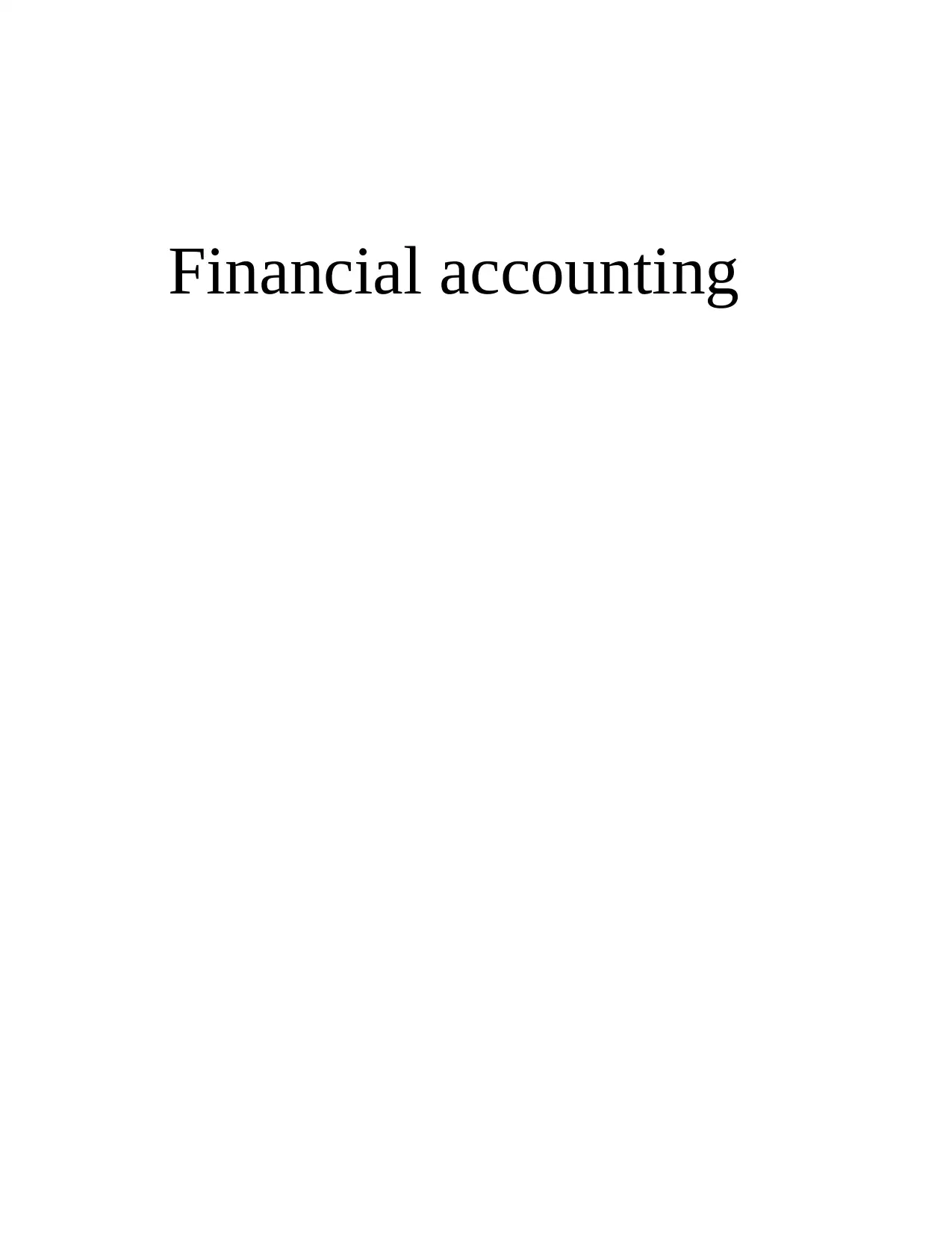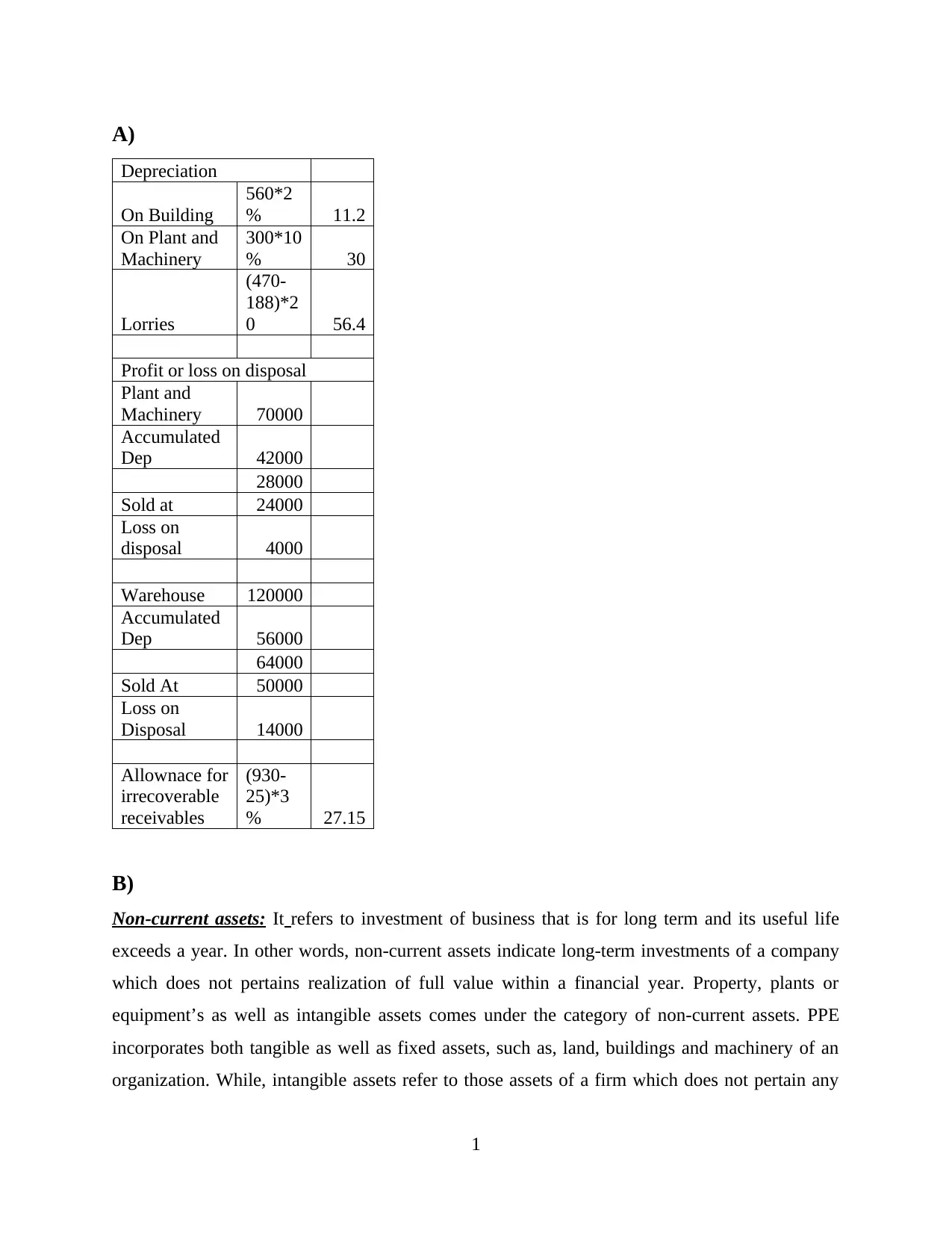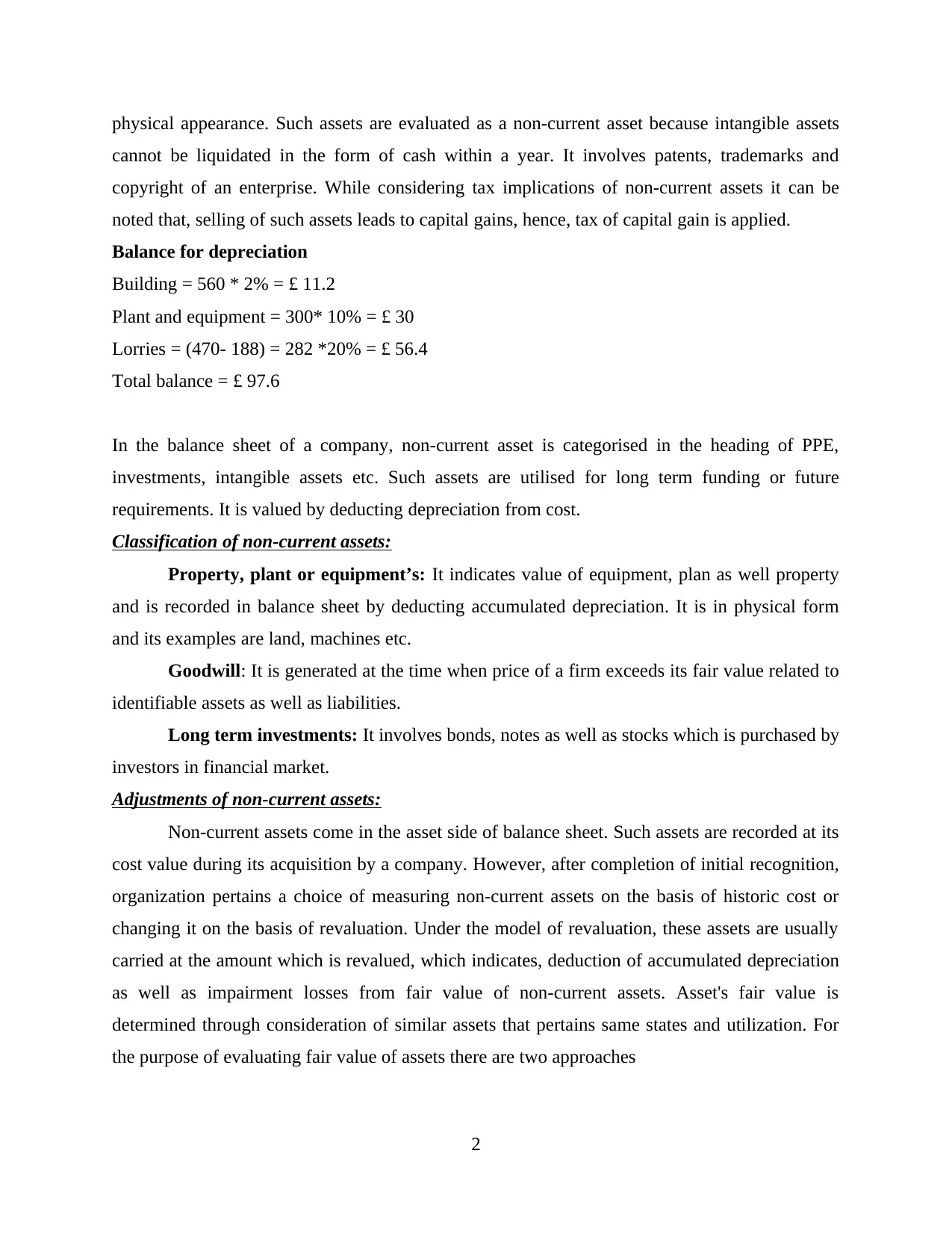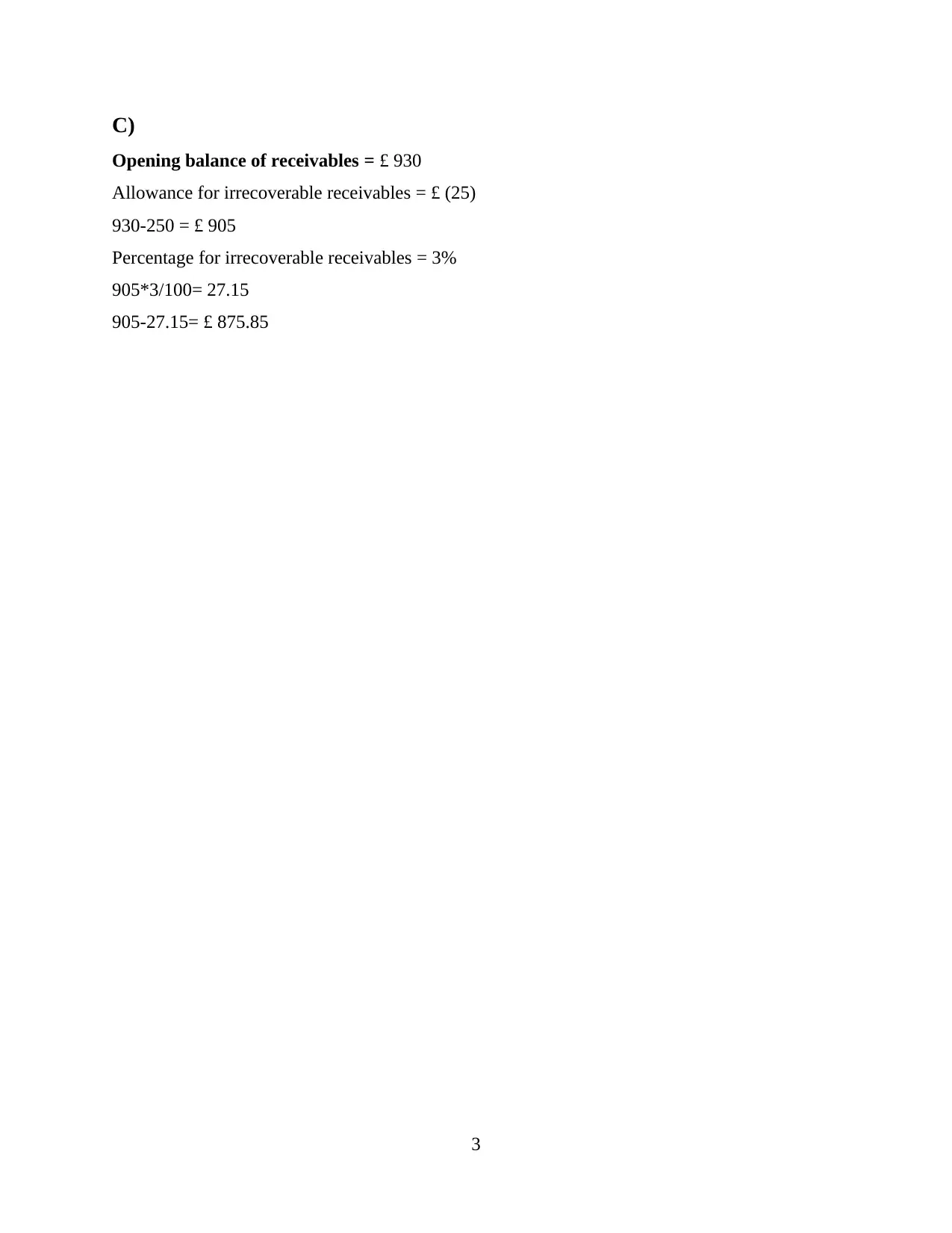Financial Accounting Homework - Depreciation, Assets, and Receivables
VerifiedAdded on 2022/12/27
|5
|617
|41
Homework Assignment
AI Summary
This document presents a detailed solution to a financial accounting homework assignment, covering several key areas. The solution includes calculations for depreciation on buildings, plant and machinery, and lorries, along with the profit or loss on the disposal of assets. It also explains the concept of non-current assets, their classification (property, plant, equipment, and goodwill), and the adjustments involved in their valuation. Furthermore, the assignment addresses the calculation of allowance for irrecoverable receivables, providing a step-by-step breakdown of the process. This resource from Desklib offers students a comprehensive understanding of these critical accounting principles.

Financial accounting
Paraphrase This Document
Need a fresh take? Get an instant paraphrase of this document with our AI Paraphraser

Contents
Contents...........................................................................................................................................2
A).....................................................................................................................................................1
B).....................................................................................................................................................1
C).....................................................................................................................................................2
Contents...........................................................................................................................................2
A).....................................................................................................................................................1
B).....................................................................................................................................................1
C).....................................................................................................................................................2

A)
Depreciation
On Building
560*2
% 11.2
On Plant and
Machinery
300*10
% 30
Lorries
(470-
188)*2
0 56.4
Profit or loss on disposal
Plant and
Machinery 70000
Accumulated
Dep 42000
28000
Sold at 24000
Loss on
disposal 4000
Warehouse 120000
Accumulated
Dep 56000
64000
Sold At 50000
Loss on
Disposal 14000
Allownace for
irrecoverable
receivables
(930-
25)*3
% 27.15
B)
Non-current assets: It refers to investment of business that is for long term and its useful life
exceeds a year. In other words, non-current assets indicate long-term investments of a company
which does not pertains realization of full value within a financial year. Property, plants or
equipment’s as well as intangible assets comes under the category of non-current assets. PPE
incorporates both tangible as well as fixed assets, such as, land, buildings and machinery of an
organization. While, intangible assets refer to those assets of a firm which does not pertain any
1
Depreciation
On Building
560*2
% 11.2
On Plant and
Machinery
300*10
% 30
Lorries
(470-
188)*2
0 56.4
Profit or loss on disposal
Plant and
Machinery 70000
Accumulated
Dep 42000
28000
Sold at 24000
Loss on
disposal 4000
Warehouse 120000
Accumulated
Dep 56000
64000
Sold At 50000
Loss on
Disposal 14000
Allownace for
irrecoverable
receivables
(930-
25)*3
% 27.15
B)
Non-current assets: It refers to investment of business that is for long term and its useful life
exceeds a year. In other words, non-current assets indicate long-term investments of a company
which does not pertains realization of full value within a financial year. Property, plants or
equipment’s as well as intangible assets comes under the category of non-current assets. PPE
incorporates both tangible as well as fixed assets, such as, land, buildings and machinery of an
organization. While, intangible assets refer to those assets of a firm which does not pertain any
1
⊘ This is a preview!⊘
Do you want full access?
Subscribe today to unlock all pages.

Trusted by 1+ million students worldwide

physical appearance. Such assets are evaluated as a non-current asset because intangible assets
cannot be liquidated in the form of cash within a year. It involves patents, trademarks and
copyright of an enterprise. While considering tax implications of non-current assets it can be
noted that, selling of such assets leads to capital gains, hence, tax of capital gain is applied.
Balance for depreciation
Building = 560 * 2% = £ 11.2
Plant and equipment = 300* 10% = £ 30
Lorries = (470- 188) = 282 *20% = £ 56.4
Total balance = £ 97.6
In the balance sheet of a company, non-current asset is categorised in the heading of PPE,
investments, intangible assets etc. Such assets are utilised for long term funding or future
requirements. It is valued by deducting depreciation from cost.
Classification of non-current assets:
Property, plant or equipment’s: It indicates value of equipment, plan as well property
and is recorded in balance sheet by deducting accumulated depreciation. It is in physical form
and its examples are land, machines etc.
Goodwill: It is generated at the time when price of a firm exceeds its fair value related to
identifiable assets as well as liabilities.
Long term investments: It involves bonds, notes as well as stocks which is purchased by
investors in financial market.
Adjustments of non-current assets:
Non-current assets come in the asset side of balance sheet. Such assets are recorded at its
cost value during its acquisition by a company. However, after completion of initial recognition,
organization pertains a choice of measuring non-current assets on the basis of historic cost or
changing it on the basis of revaluation. Under the model of revaluation, these assets are usually
carried at the amount which is revalued, which indicates, deduction of accumulated depreciation
as well as impairment losses from fair value of non-current assets. Asset's fair value is
determined through consideration of similar assets that pertains same states and utilization. For
the purpose of evaluating fair value of assets there are two approaches
2
cannot be liquidated in the form of cash within a year. It involves patents, trademarks and
copyright of an enterprise. While considering tax implications of non-current assets it can be
noted that, selling of such assets leads to capital gains, hence, tax of capital gain is applied.
Balance for depreciation
Building = 560 * 2% = £ 11.2
Plant and equipment = 300* 10% = £ 30
Lorries = (470- 188) = 282 *20% = £ 56.4
Total balance = £ 97.6
In the balance sheet of a company, non-current asset is categorised in the heading of PPE,
investments, intangible assets etc. Such assets are utilised for long term funding or future
requirements. It is valued by deducting depreciation from cost.
Classification of non-current assets:
Property, plant or equipment’s: It indicates value of equipment, plan as well property
and is recorded in balance sheet by deducting accumulated depreciation. It is in physical form
and its examples are land, machines etc.
Goodwill: It is generated at the time when price of a firm exceeds its fair value related to
identifiable assets as well as liabilities.
Long term investments: It involves bonds, notes as well as stocks which is purchased by
investors in financial market.
Adjustments of non-current assets:
Non-current assets come in the asset side of balance sheet. Such assets are recorded at its
cost value during its acquisition by a company. However, after completion of initial recognition,
organization pertains a choice of measuring non-current assets on the basis of historic cost or
changing it on the basis of revaluation. Under the model of revaluation, these assets are usually
carried at the amount which is revalued, which indicates, deduction of accumulated depreciation
as well as impairment losses from fair value of non-current assets. Asset's fair value is
determined through consideration of similar assets that pertains same states and utilization. For
the purpose of evaluating fair value of assets there are two approaches
2
Paraphrase This Document
Need a fresh take? Get an instant paraphrase of this document with our AI Paraphraser

C)
Opening balance of receivables = £ 930
Allowance for irrecoverable receivables = £ (25)
930-250 = £ 905
Percentage for irrecoverable receivables = 3%
905*3/100= 27.15
905-27.15= £ 875.85
3
Opening balance of receivables = £ 930
Allowance for irrecoverable receivables = £ (25)
930-250 = £ 905
Percentage for irrecoverable receivables = 3%
905*3/100= 27.15
905-27.15= £ 875.85
3
1 out of 5
Related Documents
Your All-in-One AI-Powered Toolkit for Academic Success.
+13062052269
info@desklib.com
Available 24*7 on WhatsApp / Email
![[object Object]](/_next/static/media/star-bottom.7253800d.svg)
Unlock your academic potential
Copyright © 2020–2025 A2Z Services. All Rights Reserved. Developed and managed by ZUCOL.





